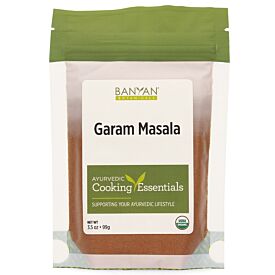Featured Ayurvedic Recipe: Garam Masala Spice Blend
/What is Masala?
Masalas are spice mixtures or spice blends used in Ayurvedic cooking. The spice cabinet is often called the home pharmacy in many Ayurvedic households. Spices add flavor to food and they make great substitutes for salt and fats in cooking. Spices also have many healing benefits to both body and mind. Masalas are often made with the seasons and feature spices that are balancing to the dosha, energetics, and tastes associated with that season.
Fall Masalas are vata-pacifying, heating, and feature the tastes of sweet, sour and salty.
Winter Masalas are kapha-pacifying, heating, and feature the tastes of pungent, bitter and astringent.
Early-Spring Masalas are kapha-pacifying, heating and feature the tastes of pungent, bitter and astringent.
Late-Spring Masalas are pitta-pacifying, cooling and feature the tastes of sweet, bitter and astringent.
Summer Masalas are pitta-pacifying, cooling and feature the tastes of sweet, bitter and astringent.
Spice-grinding is a beautiful and mindful way to prepare healthy, nourishing food. The act of hand-grinding spices connect us with the earth and acts as a meditation-in-motion. The mortar and pestle is the most common spice grinding tool, but many Ayurvedic kitchens also employ the sil batta, with is a “sil” or a base made of flat stone and a “batta” is a stone hand roller used to grind spices.
Garam Masala is one of the most recognizable spice blends from India and it comes from the northern region of India. It is regularly used in Indian cooking much in the same way salt and pepper is used in America. Garam Masala is generally used at the end of the cooking process since the spices are already ground. When cooking with spices, whole seeds are used at the beginning of the cooking process to infuse flavor into fats and to impart their flavor to the vegetables, soups, stews, curries and meats. Ground spices are often sprinkled on top of cooked food just before serving or added in the final moments of the cooking process.
This Garam Masala spice blend features 4 of the 6 tastes of sweet, pungent, bitter and astringent. In general, most spices are considered pungent. Pungent is a taste that can be aggravating to vata and pitta dosha, but when used in spice blends, the amount is small enough not to create imbalances in vata and pitta. Pungent spices also help to stoke agni or the digestive fire, which is beneficial for all the dosha. The Garam Masala is a good year-round spice blend that is tridoshic, meaning balancing for all dosha.
Sweet: cardamom, cinnamon, coriander, nutmeg
Pungent: black peppercorns, cardamom, cayenne, cinnamon, clove, cumin, nutmeg, star anise
Bitter: cumin
Astringent: coriander, nutmeg
Garam Masala Spice Blend
1/2 tablespoon coriander seeds
1/2 tablespoon cumin seeds
2 teaspoons cardamom seeds
2 teaspoons cinnamon powder
1 teaspoon whole cloves
1/2 teaspoon fresh ground nutmeg
1/2 teaspoon black peppercorns
1/4 tsp ground cayenne (optional)
1-2 star anise pods (optional)
Directions:
1. Toast (coriander seeds, cumin seeds, cardamom seeds, cloves and black peppercorns) separately in a dry pan over medium to medium-low heat until fragrant.
2. Grind each toasted spice separately in a mortar and pestle or sil batta.
3. Add each spice together in a bowl and mix to combine.
Doshic Considerations
This Garam Masala recipe can be tailored to any dosha by following the recommendations listed below.
Vata should use half the amount of cayenne or eliminate all together.
Pitta should eliminate the cayenne, half the amount of cloves and nutmeg, and consider using only half the amount of star anise or eliminate all together.
Kapha can add additional cayenne if desired.
“When you create a masala you are building the cosmic pillars for primal nourishment through food, breath and sound. You are honing the vibration of the mind and resuscitating the spirit, bringing them into a state of heightened awareness. The nose becomes a direct route to consciousness; the eyes, the gateway to light; the ears, a pathway to peace. The tongue receives the blessings of flavors, and the sense of touch leads the way to reforming your experience. ”



